Holy Lance
The Holy Lance, also known as the Lance of Longinus (named after Saint Longinus), the Spear of Destiny, or the Holy Spear, is the lance that pierced the side of Jesus as he hung on the cross during his crucifixion.
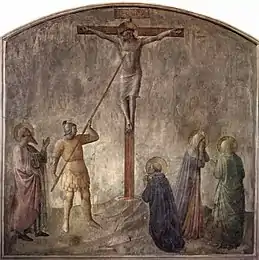
Biblical references
The lance (Greek: λόγχη, lonkhē) is mentioned in the Gospel of John,[1] but not the Synoptic Gospels. The gospel states that the Romans planned to break Jesus' legs, a practice known as crurifragium, which was a method of hastening death during a crucifixion. Because it was the eve of the Sabbath (Friday sundown to Saturday sundown), the followers of Jesus needed to "entomb" him because of Sabbath laws. Just before they did so, they noticed that Jesus was already dead and that there was no reason to break his legs ("and no bone will be broken"[2][lower-alpha 1]). To make sure that he was dead, a Roman soldier (named in extra-Biblical tradition as Longinus) stabbed him in the side.
One of the soldiers pierced his side with a lance (λόγχη), and immediately there came out blood and water.
Liturgical re-enactments
The phenomenon of blood and water was considered a miracle by Origen. Catholics, while accepting the biological reality of blood and water as emanating from the pierced heart and body cavity of Christ, also acknowledge the allegorical interpretation: it represents one of the main key teachings/mysteries of the Church, and one of the main themes of the Gospel of Matthew, which is the homoousian interpretation adopted by the First Council of Nicaea, that "Jesus Christ was both true God and true man." The blood symbolizes his humanity, the water his divinity. A ceremonial evocation of this is found in a Catholic Mass: The priest pours a small amount of water into the wine before the consecration, an act which acknowledges Christ's humanity and divinity and recalls the issuance of blood and water from Christ's side on the cross. Saint Faustina Kowalska, a Polish nun whose advocacy and writings led to the establishment of the Divine Mercy devotion, also acknowledged the miraculous nature of the blood and water, explaining that the blood is a symbol of the divine mercy of Christ, while the water is a symbol of His divine compassion and of baptismal waters.
In most variants of the Orthodox Divine Liturgy, the priest lances the host (prosphoron) with a liturgical spear before it is divided in honor of the Trinity, the Theotokos (Virgin Mary), and various other remembrances. The deacon recites the relevant passage from the Gospel of John, along with sections of the Acts of the Apostles dealing with commemoration of the saints. Most of these pieces, set aside, become the antidoron to be distributed after the liturgy, a relic of the ancient agape feasts of apostolic times, considered to be blessed but not consecrated or sanctified in the Western understanding. The main piece becomes the lamb, the host that is consecrated on the altar and distributed to the faithful for Holy Communion.
Longinus
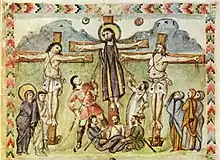
The name of the soldier who pierced Christ's side with a lonchē is not given in the Gospel of John, but in the oldest known references to the legend, the apocryphal Gospel of Nicodemus appended to late manuscripts of the 4th century Acts of Pilate, the soldier is identified as a centurion and called Longinus (making the spear's Latin name Lancea Longini).
A form of the name Longinus occurs on a miniature in the Rabula Gospels (conserved in the Laurentian Library, Florence), which was illuminated by one Rabulas in the year 586. In the miniature, the name LOGINOS (ΛΟΓΙΝΟϹ) is written in Greek characters above the head of the soldier who is thrusting his lance into Christ's side. This is one of the earliest records of the name, if the inscription is not a later addition.[lower-alpha 2]
Relics
At least four major relics are claimed to be the Holy Lance or parts of it.
Rome
A relic described as the Holy Lance in Rome is preserved beneath the dome of Saint Peter's Basilica, although the Catholic Church makes no claim as to its authenticity. The first historical reference to a lance was made in AD 570 by an unknown pilgrim from Piacenza (often erroneously identified with St. Antoninus of Piacenza) in his descriptions of the holy places of Jerusalem, writing that he saw in the Basilica of Mount Zion "the crown of thorns with which Our Lord was crowned and the lance with which He was struck in the side",[3]: 18 [4] although there is uncertainty about the exact site to which he refers.[3]: 42 A lance is mentioned in the so-called Breviarius at the Church of the Holy Sepulchre. The alleged presence in Jerusalem of the relic is attested by Cassiodorus (c. 485–585)[5][6] as well as by Gregory of Tours (c. 538–594), who had not actually been to Jerusalem.
In 615, Jerusalem was captured by the Persian forces of King Khosrau II (Chosroes II). According to the Chronicon Paschale, the point of the lance, which had been broken off, was given in the same year to Nicetas, who took it to Constantinople and deposited it in the church of Hagia Sophia, and later to the Church of the Virgin of the Pharos. This point of the lance, which was now set in an icon, was acquired by the Latin Emperor Baldwin II of Constantinople, who later sold it to Louis IX of France. The point of the lance was then enshrined with the crown of thorns in the Sainte Chapelle in Paris. During the French Revolution these relics were removed to the Bibliothèque Nationale but the point subsequently disappeared.[7]
As for the larger portion of the lance, Arculpus claimed he saw it at the Church of the Holy Sepulchre around 670 in Jerusalem, but there is otherwise no mention of it after the sack in 615. Some claim that the larger relic had been conveyed to Constantinople in the 8th century, possibly at the same time as the Crown of Thorns. At any rate, its presence at Constantinople seems to be clearly attested by various pilgrims, particularly Russians, and, though it was deposited in various churches in succession, it seems possible to trace it and distinguish it from the relic of the point. Sir John Mandeville declared in 1357 that he had seen the blade of the Holy Lance both at Paris and at Constantinople, and that the latter was a much larger relic than the former; it is worth adding that Mandeville is not generally regarded as one of the Middle Ages' most reliable witnesses, and his supposed travels are usually treated as an eclectic amalgam of myths, legends and other fictions. "The lance which pierced Our Lord's side" was among the relics at Constantinople shown in the 1430s to Pedro Tafur, who added "God grant that in the overthrow of the Greeks they have not fallen into the hands of the enemies of the Faith, for they will have been ill-treated and handled with little reverence."[8]
Whatever the Constantinople relic was, it did fall into the hands of the Turks, and in 1492, under circumstances minutely described in Pastor's History of the Popes, the Sultan Bayezid II sent it to Pope Innocent VIII to encourage the pope to continue to keep his brother and rival Zizim (Cem Sultan) prisoner. At this time great doubts as to its authenticity were felt at Rome, as Johann Burchard records,[9] because of the presence of other rival lances in Paris (the point that had been separated from the lance), Nuremberg (see Holy Lance in Vienna below), and Armenia (see Holy Lance in Echmiadzin below). In the mid-18th century Pope Benedict XIV states that he obtained from Paris an exact drawing of the point of the lance, and that in comparing it with the larger relic in St. Peter's he was satisfied that the two had originally formed one blade.[10] This relic has never since left Rome, and its resting place is at Saint Peter's.
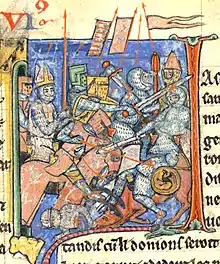 A mitred Adhémar de Monteil carrying one of the instances of the Holy Lance in one of the battles of the First Crusade
A mitred Adhémar de Monteil carrying one of the instances of the Holy Lance in one of the battles of the First Crusade 1898 drawing of the Holy Lance in Rome
1898 drawing of the Holy Lance in Rome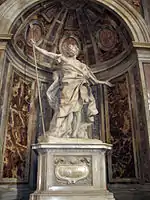 The statue of St Longinus by Gianlorenzo Bernini sits above the relic in St Peter's Basilica
The statue of St Longinus by Gianlorenzo Bernini sits above the relic in St Peter's Basilica
Vienna
The Holy Lance in Vienna is displayed in the Imperial Treasury or Weltliche Schatzkammer (lit. Worldly Treasure Room) at the Hofburg Palace in Vienna, Austria. It is a typical winged lance of the Carolingian dynasty.[11] At different times, it was said to be the lance of Saint Maurice or that of Constantine the Great.[12] In the tenth century, the Holy Roman Emperors came into possession of the lance, according to sources from the time of Otto I (912–973). In 1000, Otto III gave Bolesław I of Poland a replica of the Holy Lance at the Congress of Gniezno. In 1084, Henry IV had a silver band with the inscription "Nail of Our Lord" added to it. This was based on the belief that the nail embedded in the spear-tip was one that had been used for the Crucifixion of Jesus. It was only in the thirteenth century that the Lance became identified with that of Longinus, which had been used to pierce Christ's side and had been drenched in water and the blood of Christ.[11]
In 1273, the Holy Lance was first used in a coronation ceremony. Around 1350, Charles IV had a golden sleeve put over the silver one, inscribed Lancea et clavus Domini (Lance and nail of the Lord). In 1424, Sigismund had a collection of relics, including the lance, moved from his capital in Prague to his birthplace, Nuremberg, and decreed them to be kept there forever. This collection was called the Imperial Regalia (Reichskleinodien).
When the French Revolutionary army approached Nuremberg in the spring of 1796, the city councilors decided to remove the Reichskleinodien to Vienna for safe keeping. The collection was entrusted to a Baron von Hügel, who promised to return the objects once the threat was resolved.[12] However, the Holy Roman Empire was disbanded in 1806 and in the confusion, he sold the collection to the Habsburgs.[12] The city councillors asked for the return of the collection after the defeat of Napoleon’s army at the Battle of Waterloo, but the Austrian authorities refused.[12]
In Mein Kampf, Hitler wrote that the Imperial Insignia "were still preserved in Vienna and appeared to act as magical relics rather than as the visible guarantee of an everlasting bond of union. When the Habsburg State crumbled to pieces in 1918, the Austrian Germans instinctively raised an outcry for union with their German fatherland".[13] During the Anschluss, when Austria was annexed to Germany, the Nazis brought the Reichskleinodien to Nuremberg, where they displayed them during the September 1938 Party Congress. They then transferred them to the Historischer Kunstbunker, a bunker that had been built into some of the medieval cellars of old houses underneath Nuremberg Castle to protect historic art from air raids.[14]
Most of the Regalia were recovered by the Allies at the end of the war, but the Nazis had hidden the five most important pieces in hopes of using them as political symbols to help them rally for a return to power, possibly at the command of Nazi Commander Heinrich Himmler.[14] Walter Horn — a Medieval studies scholar who had fled Nazi Germany and served in the Third Army under General George S. Patton — became a special investigator in the Monuments, Fine Arts, and Archives program after the end of the war, and was tasked with tracking the missing pieces down.[14] After a series of interrogations and false rumors, Nuremberg city councilor Stadtrat Fries confessed that he, fellow-councilman Stadtrat Schmeiszner, and an SS official had hidden the Imperial Regalia on March 31, 1945, and he agreed to bring Horn's team to the site.[14] On August 7, Horn and a U.S. army captain escorted Fries and Schmeiszner to the entrance of the Panier Platz Bunker, where they located the treasures hidden behind a wall of masonry in a small room off of a subterranean corridor, roughly eighty feet below ground.[14] The Regalia were first brought back to Nuremberg castle to be reunited with the rest of the Reichskleinodien, and then transferred with the entire collection to Austrian officials the following January.[14]
The Kunsthistorisches Museum has dated the lance to the 8th century.[11] Robert Feather, an English metallurgist and technical engineering writer, tested it for a documentary in January 2003.[12][15][16] He was given unprecedented permission not only to examine the lance in a laboratory environment, but to remove the delicate bands of gold and silver that hold it together. Based on X-ray diffraction, fluorescence tests, and other noninvasive procedures, he dated the main body of the spear to the 7th century at the earliest.[12][16] Feather stated in the same documentary that an iron pin – long claimed to be a nail from the crucifixion, hammered into the blade and set off by tiny brass crosses – was "consistent" in length and shape with a 1st-century AD Roman nail.[16] There was no residue of human blood on the lance.[12]
Not long afterward, researchers at the Interdisciplinary Research Institute for Archeology in Vienna used X-ray and other technology to examine a range of lances, and determined that the Vienna lance dates from around the 8th to the beginning of the 9th century, with the nail apparently being of the same metal, and ruled out the possibility of it dating back to the 1st century AD.[17]
-3-2.jpg.webp) Holy Lance displayed in the Imperial Treasury at the Hofburg Palace in Vienna, Austria
Holy Lance displayed in the Imperial Treasury at the Hofburg Palace in Vienna, Austria Polish replica of the Holy Lance, Wawel Hill, Krakow
Polish replica of the Holy Lance, Wawel Hill, Krakow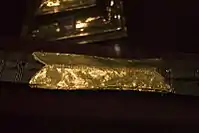 The inscription on the Holy Lance
The inscription on the Holy Lance
Vagharshapat

A Holy Lance is conserved in Vagharshapat (previously known as Echmiadzin), the religious capital of Armenia. It was previously held in the monastery of Geghard. The first source that mentions it is a text Holy Relics of Our Lord Jesus Christ, in a thirteenth-century Armenian manuscript. According to this text, the spear which pierced Jesus was to have been brought to Armenia by the Apostle Thaddeus. The manuscript does not specify precisely where it was kept, but the Holy Lance gives a description that exactly matches the lance, the monastery gate, since the thirteenth century precisely, the name of Geghardavank (Monastery of the Holy Lance).
In 1655, the French traveler Jean-Baptiste Tavernier was the first Westerner to see this relic in Armenia. In 1805, the Russians captured the monastery and the relic was moved to Tchitchanov Geghard, Tbilisi, Georgia. It was later returned to Armenia, and is still on display at the Manoogian museum in Vagharshapat, enshrined in a 17th-century reliquary.
Antioch
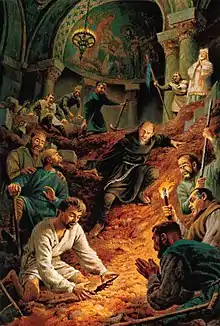
During the June 1098 Siege of Antioch, a monk named Peter Bartholomew reported that he had a vision in which St. Andrew told him that the Holy Lance was buried in the Church of St. Peter in Antioch. After much digging in the cathedral, Bartholomew allegedly discovered a lance. Despite the doubts of many, including the papal legate Adhemar of Le Puy, the discovery of the Holy Lance of Antioch inspired the starving Crusaders to break the siege and secure the city.[18]
In the 18th century, Roman cardinal Prospero Lambertini claimed the Antiochian lance was a fake.
Literary
.jpg.webp)
In his opera Parsifal, Richard Wagner identifies the Holy Spear with two items that appear in Wolfram von Eschenbach's medieval poem Parzival: a bleeding spear in the Castle of the Grail and the spear that has wounded the Fisher King. The opera's plot concerns the consequences of the spear's loss by the Knights of the Grail and its recovery by Parsifal. Having decided that the blood on the Spear was that of the wounded Saviour – Jesus is never named in the opera – Wagner has the blood manifest itself in the Grail rather than on the spearhead.[19]
In popular culture
- The spear of Longinus plays a significant role in Robin Jarvis' Tales from the Wyrd Museum series of novels.
- The Spear of Destiny is the main plot device in the television movie The Librarian: Quest for the Spear.
- The spear of Longinus is mentioned briefly in Hellboy (2004), a loose cinematic adaptation of the graphic novel, Hellboy: Seed of Destruction, as a supernatural artifact in the collection of the BPRD.[20]
- The Spear of Destiny is a central plot point in the film Constantine (2005) as the “blood of the son of God” is used to bring about “the birth of the son of the devil.”
- In the 1990s anime TV show Neon Genesis Evangelion, the Lance of Longinus is a giant bident found in the body of Lilith, the Second Angel. It is shown to have incredible destructive power.
- Longinus is a recurring spear in the Final Fantasy series. It often is the most powerful spear in the games.
- Longinus is both a weapon and a demon in multiple Shin Megami Tensei games. It has an important role in Persona 2: Innocent Sin, where the Order of the Holy Lance carry copies of the Longinus Spear while Adolf Hitler carries the real one.
- In the strategy board game Kingdom Death: Monster the Lance of Longinus is a weapon gear card available for players to craft.
- Saint Longinus is referenced in the second season of DC's Legends of Tomorrow and most of the season is about trying to find the "spear of destiny" that he used to kill Christ.
- In the Japanese Light Novel Series Highschool DxD the Holy Lance is a weapon owned by Cao Cao, with the name of the True Longinus.
- In the OVA Bible Black: New Testament, the Lance of Longinus is an artifact sought and fought over by two demonic entities.
- In the DC Universe, the Spear of Destiny was in the hands of Adolf Hitler, which enabled magical spheres of influence around Axis territories, which would take control of any superpowered superheroes who dared enter them. With that threat, the superhero community was forced to relegate their participation in World War II to a purely defensive role in Allied territories.
- In the SCP Foundation, the spear of Longinus is mentioned as the Spear of the Non-Believer, said to be a weapon capable of killing gods.
- In The Great Seljuks: Guardians of Justice, the Holy Spear is used by the Crusader commander Markus as a weapon in combat, before being seized by Sultan Melikşah,[21] with a fake version being used to poison the Byzantine prince Isaakios.
- In Demonic (2021), the Holy Lance is used by the protagonist (Carly Pope) to defeat a demon.
- The lance appears in The God of High School, being used by Mujin Park, with Longinus being his Borrowed Power.
- In Sky Atlantic drama Britannia (TV series) (2021), Lucius, Prefectus to Roman General Aulus Plautus, deserts the legion to aid Cait, a Briton in her quest for the ‘Spear of the Silver Dawn’, which Lucius buried 10 years earlier whilst on campaign in eastern lands. There are loose references to this spear, implying that Lucius was the Roman Soldier who pierced Christ with a spear, whilst on the cross.
- In the novel Battle Ground of the fantasy series "The Dresden Files", Harry Dresden attempts to use the head of the lance, newly attached to his staff, to injure the Titan Ethniu, saying, "Well, it was good enough for the Saviour". He had previously stolen it from the treasure vaults of Hades in the novel Skin Game.
See also
- Relics associated with Jesus
- Arma Christi
- Crown of thorns
- Holy Chalice
- Holy Sponge
- Image of Edessa
- Seamless robe of Jesus
- Shroud of Turin
- Titulus Crucis
- True Cross
- The Spear of Destiny, 1972 novel
- The Spear, 1978 novel
- The Librarian: Quest for the Spear, 2004 film
Explanatory notes
- This verse is reference to Psalms 34:20 regarding the righteous person, and commandments concerning the paschal lamb in Exodus 12:46 and Numbers 9:12.
- The text is Syriac, the lettering Greek.
Citations
- John 19:31–37
- John 19:36
- Stewart, Aubrey; Wilson, CW, eds. (1896). Of the Holy Places Visited by Antoninus Martyr (Circ. 560-570 A.D.). London: Palestine Pilgrims' Text Society. pp. 14. Retrieved 16 April 2019.
- Herbert Thurston (1910). "The Holy Lance". In Catholic Encyclopedia. Vol. 8. New York: Robert Appleton Company.
- Ps. lxxxvi, P.L., LXX, 621
- Cassiodorus, Expositio in Psalterium (Explanation of the Psalms) lxxxvi, (printed in Migne, Patrologia Latina, LXX, 621).
- The later history is reported from the Catholic Encyclopedia.
- Ross, Sir E. Denison; Power, Eileen, eds. (1926). Pero Tafur: Travels and Adventures (1435-1439). Translated by Letts, Malcolm. New York: Harper & Brothers. Archived from the original on 29 June 2011. Retrieved 1 April 2019.
- "Diary" I, 473–486, ed. Thusasne
- De Beat. et Canon., IV, ii, 31
- "Die Heilige Lanze". Kunsthistorisches Museum. Retrieved 25 June 2018.
- Kerby, Rob (April 2004). "Does Russia have the spear that pierced Jesus' side?". Beliefnet. Archived from the original on 26 June 2018. Retrieved 25 June 2018.
- Hitler, Adolf (February 1939). Mein Kampf [My Struggle]. Translated by Murphy, James. Project Gutenberg of Australia. p. 21. Retrieved 1 April 2019.
- Ueno, Rihoko (11 April 2014). "Recovering Gold and Regalia: a Monuments Man investigates". Archives of American Art. The Smithsonian Institution. Archived from the original on 26 June 2018. Retrieved 25 June 2018.
- Lunghi, Cheri (narrator), Spear of Christ, BBC/Discovery Channel, Atlantic Productions, 2003, archived from the original on 12 December 2004, retrieved 1 January 2007
- Bird, Maryann (8 June 2003). "Piercing An Ancient Tale: Solving the mystery of a Christian relic". Time. Archived from the original on 3 August 2003. Retrieved 25 June 2018.
- "Der geheimnisvolle Kreuznagel". ZDF. 4 September 2004. Archived from the original on 12 November 2004. Retrieved 25 June 2018.
- Runciman, Steven (1987). A History of the Crusades, Volume 1: The First Crusade and the Foundation of the Kingdom of Jerusalem. Cambridge University Press. pp. 241–245. ISBN 978-0-521-34770-9.
- Beckett, Lucy (1981). Richard Wagner: Parsifal. Cambridge University Press. pp. 16–17. ISBN 0-521-29662-5.
- Hellboy: Seed of Destruction Dark Horse
- "Uyanış Büyük Selçuklu son bölüm izle! İzakyos, mızrağı Melikşah'tan almak için ne yapacak?". Sabah (in Turkish). 2 March 2021. Retrieved 28 July 2021.
General and cited references
- Brown, Arthur Charles Lewis. Bleeding Lance. Modern Language Association of America, 1910
- Hone, William. The Lost Books of the Bible. Bell Publishing Co., 1979.
- Kirchweger, Franz, ed. Die Heilige Lanze in Wien. Insignie – Reliquie – Schicksalsspeer [The Holy Lance in Vienna. Insignia – Relic – Spear of Destiny]. Vienna: Kunsthistorisches Museum, 2005.
- Kirchweger, Franz. "Die Geschichte der Heiligen Lanze vom späteren Mittelalter bis zum Ende des Heiligen Römischen Reiches (1806) [The History of the Holy Lance from the Later Middle Ages to the End of the Holy Roman Empire (1806)]." Die Heilige Lanze in Wien. Insignie – Reliquie – Schicksalsspeer. Vienna: Kunsthistorisches Museum, 2005, 71–110.
- Morris, Colin. "Policy and vision: The case of the Holy Lance found at Antioch", in John Gillingham & J. C. Holt, War and Government in the Middle Ages: Essays in honour of J. O. Prestwich, Boydell, 1984, pp. 33–45
- Schier, Volker and Corine Schleif. "The Holy Lance as Late Twentieth-century Subcultural Icon." Subcultural Icons, edited by Keyan Tomaselli and David Scott. Walnut Creek: Left Coast Press, 2009, 103–134.
- Schier, Volker and Corine Schleif. "Die heilige und die unheilige Lanze. Von Richard Wagner bis zum World Wide Web [The Holy and the Unholy Lance. From Richard Wagner to the World Wide Web]". Die Heilige Lanze in Wien. Insignie - Reliquie - Schicksalsspeer, edited by Franz Kirchweger. Vienna: Kunsthistorisches Museum, 2005, 111–144.
- Schier, Volker and Corine Schleif. "Seeing and Singing, Touching and Tasting the Holy Lance. The Power and Politics of Embodied Religious Experiences in Nuremberg, 1424–1524". Signs of Change. Transformations of Christian Traditions and their Representation in the Arts, 1000–2000, edited by Nils Holger Petersen, Claus Cluver, and Nicolas Bell. Amsterdam; New York: Rodopi, 2004, 401–426.
- Schleif, Corine and Volker Schier. "The Feast of the Holy Lance: Image, Text, Music, Gender." Opening the Geese Book. geesebook
.asu (video also on vimeo.edu /how .htm .com ). Tempe, 2020./486319249 - Schleif, Corine and Volker Schier. "The Feast of the Holy Lance: History, Politics, and Liturgy." Opening the Geese Book. geesebook
.asu (video also on vimeo.edu /how .htm .com ). Tempe, 2020./486321988 - Sheffy, Lester Fields. Use of the Holy Lance in the First Crusade. L.F. Sheffy, 1915.
External links
- "Piercing an Ancient Tale"—An article by Maryann Bird in the European Edition of Time on British metallurgist Robert Feather’s scientific examination of the Spear in Vienna.